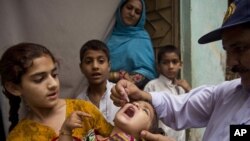The old, injectable polio vaccine will now be the primary weapon in the global effort to eradicate the paralytic illness, polio, among children. A new study finds the first vaccine to be developed against polio in the 1950s is the best for curtailing further spread.
Despite a concerted global eradication effort for more than 25 years by the World Health Organization, national governments and other groups, polio infection remains stubbornly persistent in a number of countries, including Pakistan, Nigeria and Afghanistan.
At one time, polio infected some 350,000 children per year worldwide. Anti-polio efforts have eliminated 99 percent of the cases. The goal is 100 percent eradication.
The so-called Sabin vaccine, an oral medication developed by Albert Sabin, is made up of live, weakened virus that effectively protects children against polio.
While the Sabin vaccine is cheap and easy to administer, there are drawbacks. The vaccine loses its effectiveness over time and it allows the virus to be shed in human waste to infect healthy children in endemic areas and across borders.
Now, a new study has found the Salk vaccine, the first immunization drug developed against polio by Jonas Salk, offered better protection than a second, booster dose of the oral medicine in a trial in northern India.
The Salk vaccine, which is administered by injection, uses inactivated virus to stimulate an immune response against polio. Its use dwindled in favor of the oral vaccine.
In a telephone briefing with reporters, lead researcher Hamid Jafari, the director for polio operations and research with the World Health Organization, says the injectable Salk vaccine will now be used in place of the oral medication in regions where polio infection remains a public health problem.
“It could play a major role in completing the job of polio eradication once and for all, both from the remaining endemic reservoirs and specific outbreak settings, securing a polio-free world once and for all," he said.
Polio has been eliminated in India where a trial of the Salk vaccine was conducted in about 1,000 children who had been previously vaccinated with the oral vaccine.
The research showed the Salk vaccine provided lasting intestinal immunity, to prevent the shedding of virus through the digestive track in infected children. The study is published in the journal Science.
WHO Coordinator for Research and Product Development, Polio Operations and Research Roland Sutter says the findings end a long-running debate about the most effective strategy to eradicate polio.
“The answer is now very clear," he said. "Both vaccines complement one another and should be used to interrupt the final chains of transmission to attain a polio-free world in the most rapid and effective way possible.”
Officials say the injectable vaccine would be particularly useful and provide lasting protection among children in remote areas that are difficult for public health workers to reach, including conflict zones. It would also protect youngsters from cross-border infection in countries in which polio has been eradicated.
In addition, experts are recommending the Salk vaccine be given to travelers to prevent the international spread of polio in nations where it has been eradicated.








